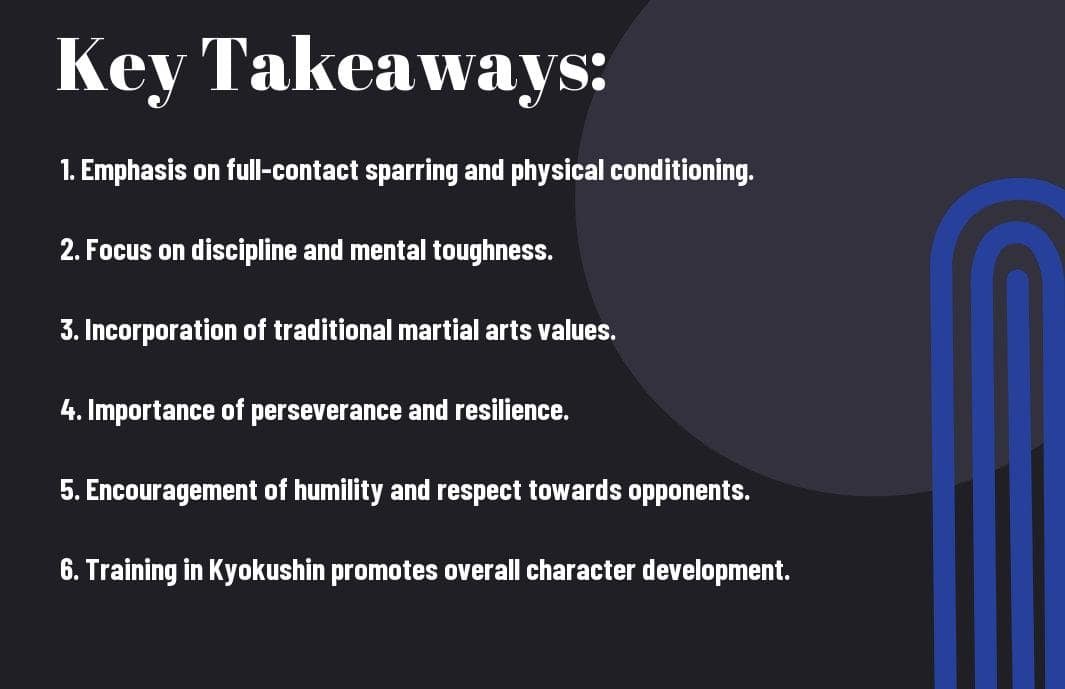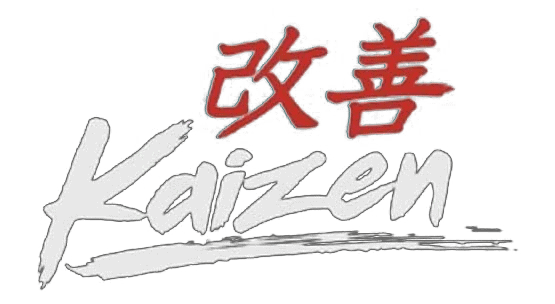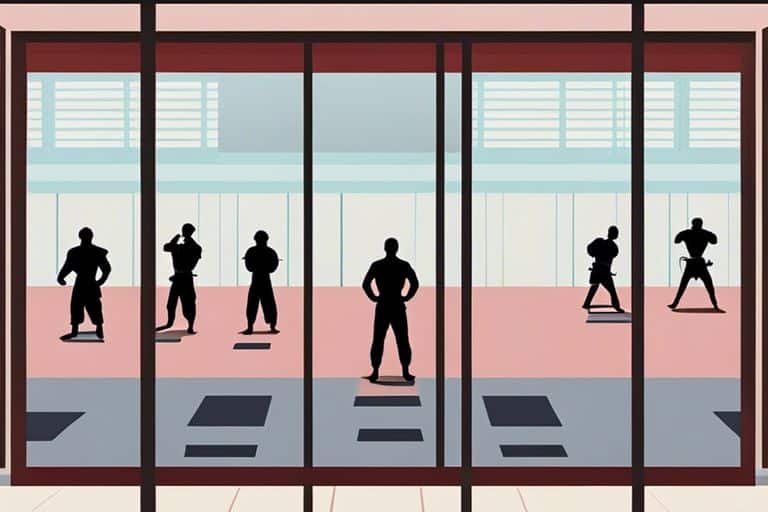Have you ever wondered how the philosophy of Kyokushin shapes the way you train? Kyokushin, known for its rigorous training methods and emphasis on discipline, is deeply rooted in its philosophical principles. In this blog post, we will explore how the fundamental tenets of Kyokushin influence the way you approach your training and transform you into a stronger, more disciplined martial artist.
Key Takeaways:
- Emphasis on physical and mental discipline: Kyokushin philosophy places a strong emphasis on developing discipline in its practitioners, both physically and mentally. This influences training by demanding a high level of dedication and focus from students.
- Focus on full-contact sparring: Kyokushin’s philosophy encourages full-contact sparring, which influences training by preparing practitioners for real-world combat situations and emphasising the importance of toughness and resilience.
- Incorporation of kata practice: Kyokushin’s philosophy includes the practice of kata, which influences training by promoting the development of technique, form, and precision in movement.
- Strong sense of community and camaraderie: The philosophy of Kyokushin emphasises the importance of mutual respect and support among students, which influences training by fostering a strong sense of community and camaraderie within the dojo.
- Encouragement of humility and respect: This philosophy encourages practitioners to approach their training with humility and respect, which influences training by promoting a positive and respectful learning environment.

The Pillars of Kyokushin Philosophy
Kyokushin is a full-contact style of karate founded in 1964 by Masutatsu Oyama. The philosophy of Kyokushin is deeply ingrained in its training methods and is based on several core principles that guide practitioners not only in their training but also in their daily lives.
The Principle of Maximum Efficiency
One of the key pillars of Kyokushin philosophy is the principle of maximum efficiency. This principle emphasises the importance of using your energy and movement in the most effective way possible. In training, this means learning to deliver powerful, precise strikes with minimal wasted movement, allowing you to generate maximum force with each technique. This focus on efficiency not only improves your martial arts skills but also carries over into your everyday actions, teaching you to do things in the most effective way possible.
Concept of Self-Improvement
Another fundamental aspect of Kyokushin philosophy is the concept of self-improvement. In Kyokushin, you are constantly encouraged to push beyond your limits, to strive for personal growth, and to never be satisfied with your current level of skill and ability. This drive for self-improvement permeates every aspect of Kyokushin training, reinforcing the idea that there is always room for growth and development, both in martial arts and in life.
The Kyokushin philosophy promotes values such as discipline, respect, and perseverance, which are essential not only in martial arts but in your everyday life as well. By embodying these principles, you can cultivate a sense of self-discipline, respect for others, and the determination to overcome challenges, both on and off the training mat. The strong emphasis on mental fortitude and physical toughness equips you with a resilient mindset that can be applied to any endeavour you undertake. By embracing the principles of Kyokushin, you can cultivate a strong, focused, and disciplined mindset that will serve you well in all areas of your life.I’m quite excited to share with you how the philosophy of Kyokushin influences training. The rigorous and holistic approach of Kyokushin Karate makes it one of the most respected and challenging martial arts in the world.
Kyokushin Training Methodology
In Kyokushin, the training methodology is designed to develop not only physical strength but also mental resilience and spiritual fortitude. The training is demanding and requires you to push your limits, both physically and mentally. The core components of Kyokushin training include Kihon (basics), Kata (forms), and Kumite (sparring).
Kihon: The Role of Basics
In Kyokushin, Kihon forms the foundation of your training. You will spend countless hours perfecting basic techniques such as punches, kicks, and stances. The emphasis on Kihon is to ensure that you have a solid understanding and mastery of the fundamental movements. This not only builds your physical strength and stamina but also hones your focus and concentration. The relentless practice of Kihon instils discipline and a strong work ethic, which are indispensable qualities in Kyokushin.
Kumite: The Significance of Sparring
Kumite, or sparring, is an integral part of Kyokushin training. It provides you with the opportunity to apply the techniques you have learned in a controlled yet dynamic environment. Sparring in Kyokushin is full-contact and intense, testing your courage, resilience, and fighting spirit. It is through Kumite that you learn to face your fears and overcome challenges, forging mental toughness and self-confidence. The strong emphasis on contact sparring in Kyokushin sets it apart from other martial arts and is a testament to its effectiveness in real-life combat situations.
In conclusion, the Kyokushin training methodology is designed to push you beyond your limits and develop not only your physical prowess but also your mental and spiritual strength. The demanding nature of the training may be daunting, but it is through overcoming these challenges that you truly grow and evolve as a martial artist. Embrace the rigorous training and let the philosophy of Kyokushin transform you into a well-rounded and resilient individual.
Mental Fortitude in Kyokushin
When it comes to training in Kyokushin, mental fortitude is as important as physical strength. The philosophy of Kyokushin emphasises the development of a strong spirit and a never-give-up attitude, which is evident in the training methods of this martial art.
The Cultivation of Spirit (Osu!)
In Kyokushin, the concept of “Osu!” is deeply ingrained in the training. “Osu!” is more than just a word; it embodies a spirit of respect, perseverance, and indomitable will. The repeated use of “Osu!” in training serves as a constant reminder to show respect, maintain discipline, and push past your limits, thus cultivating a strong spirit that enables you to overcome challenges both inside and outside the dojo.
Overcoming Personal Limits
In Kyokushin, there is a strong emphasis on pushing past your personal limits. This means that you are constantly challenging yourself to go further, hit harder, and endure more. By consistently pushing yourself beyond what you thought were your limits, you develop mental resilience and strength. Overcoming personal limits in training not only improves your physical ability but also instils a sense of confidence and mental toughness that can help you face any challenge that comes your way.
Kyokushin’s Ethical Framework
When you delve into the philosophy of Kyokushin, you will find that it is firmly rooted in an ethical framework that permeates every aspect of training and practice. This ethical framework forms the foundation of the art and is integral to understanding the mindset and approach of Kyokushin practitioners.
Discipline and Respect
In Kyokushin, discipline and respect are two of the most important principles that guide every practitioner. The emphasis on discipline fosters a strong mindset, teaching you to push your limits and work towards self-improvement. It instils a sense of determination and dedication that is crucial for success in training. The concept of respect is also deeply ingrained within the art, teaching you to show respect not only to your instructors and fellow practitioners, but also to yourself and others outside the dojo. This emphasis on discipline and respect shapes your character, instilling a sense of humility and courtesy that extends beyond the training mats.
Harmony and Community
Another key aspect of Kyokushin’s ethical framework is the emphasis placed on harmony and community. Training in Kyokushin is not just about individual achievement, it is also about cultivating a sense of unity and camaraderie within the dojo. The emphasis on harmony teaches you to work together with your training partners, cultivating a spirit of cooperation and support. This sense of community extends beyond the physical dojo, fostering a sense of connection with fellow practitioners around the world. The Kyokushin community is a tight-knit one, and the emphasis on harmony and community creates a strong support network that helps you grow as a martial artist and as an individual.
As you can see, Kyokushin’s ethical framework plays a pivotal role in shaping the mindset and approach of practitioners. It instils values that go beyond physical training, shaping your character and outlook on life. The emphasis on discipline, respect, harmony, and community creates a holistic approach to training that is not only beneficial for your martial arts journey, but also for your personal development.
Conclusion
On the whole, the philosophy of Kyokushin has a significant influence on the training methods within this martial art. By placing emphasis on discipline, respect, and endurance, the philosophy shapes the way in which you approach your training, encouraging you to push your limits and develop a strong mind and body. The focus on full-contact sparring and rigorous conditioning also reflects the philosophy’s emphasis on toughness and resilience. Through this holistic approach, Kyokushin training not only hones your physical abilities but also nurtures a strong character and mindset. Ultimately, the philosophy of Kyokushin shapes the way in which you approach every aspect of your training, instilling in you the values and principles that define this martial art.
FAQ
Q: What is the philosophy of Kyokushin?
A: The philosophy of Kyokushin is based on the principles of perseverance, discipline, and respect. It emphasises the importance of physical and mental strength, as well as humility and self-improvement.
Q: How does the philosophy of Kyokushin influence training?
A: The philosophy of Kyokushin shapes training by instilling a strong work ethic, teaching students to push their physical and mental limits, and encouraging a mindset of continuous self-improvement.
Q: What are the key principles of Kyokushin training?
A: The key principles of Kyokushin training include rigorous physical conditioning, full-contact sparring, kata practice, and an emphasis on developing a strong spirit and indomitable will.
Q: How does Kyokushin training differ from other martial arts?
A: Kyokushin training is distinguished by its emphasis on full-contact sparring, the absence of protective gear (in some cases), and a focus on developing an unyielding spirit through intense physical and mental challenges.
Q: What are the benefits of training in line with the philosophy of Kyokushin?
A: Training in line with the philosophy of Kyokushin can lead to improved physical fitness, mental resilience, self-discipline, and a strong sense of respect for oneself and others.
Q: How can I apply the philosophy of Kyokushin to my daily life?
A: You can apply the philosophy of Kyokushin to your daily life by cultivating a strong work ethic, maintaining a positive attitude, and approaching challenges with determination and a never-give-up spirit.
Q: Is Kyokushin suitable for everyone, regardless of age or fitness level?
A: Kyokushin training can be adapted to suit individuals of all ages and fitness levels, but it requires dedication and perseverance to progress and fully embody the philosophy of Kyokushin.



